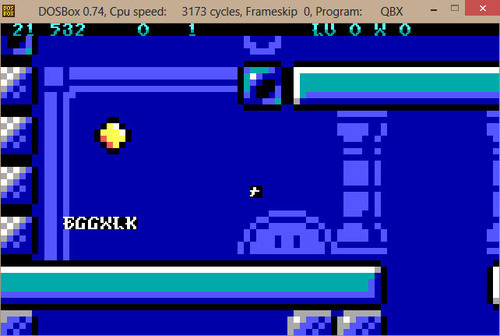
- OLD DOS GAMES CGA DRIVERS
- OLD DOS GAMES CGA DRIVER
- OLD DOS GAMES CGA SOFTWARE
- OLD DOS GAMES CGA CODE
Anyway, the easiest way to get more visuallyĪppealing games was to use the second palette – red, green, yellow and black. This with the default palette to get blue, cyan, pink and white which allowedįor better color transitions. Such trick was used in many games, but it did nothing on newer cards (EGA/VGA).Ĭhanging the color 0 (usually black) to any other color. The default one can, however, be modified usingĪ video chip register – it replaces pink with red but also disables color burst Palettes were designed for good viewing on NTSC TVs. To be used heavily when people stopped using TVs with their IBM PC compatibles. Good to add also something about the palettes for RGBI TTL monitors. Wrote a post about 16-color modes available for composite monitors but it’s Thing that comes to mind when somebody starts to talk about CGA. CGA was harder, and writing to the Hercules Graphics Adapter was really cumbersome and I never got the hang of it.Default 4-color palette with pink, cyan, black and white is probably the first I haven't had much success with the really old graphics card. Because of the two buffers, you could draw in the background, and swap a 'display pointer' when you wanted to draw the next frame.īut I admit, this was already a VGA mode. Because of the size of the screen, you could easily find the right pixel by bitshifting the Y coordinate and adding up X. This very efficient mode, allowed you to easily plot pixes (each pixel being a byte). One buffer for drawing, one buffer that was displayed. That graphics mode gave you two buffers of 64000 bytes, each byte representing a pixel on the screen. My favorite was the graphics mode '13' which was 320x200 in 256 colours.
OLD DOS GAMES CGA CODE
I tried to write some graphics/game code too that time and I used C, Basic and Assembler. The really old games were sometimes written in Assembler, as were the graphics libraries. You will still be able to do low level graphics programming, but you will get your game running much faster, will have better tech support when things break, and your game will be cross-platform. Allegro, SDL, PyGame, OpenAL, and OpenGL to name a few. Instead of doing things exactly like they did, I recommend using one of those libraries. If you just want to develop a DOS-style game, these days you have a lot of graphics and sound libraries available to you. You can use an emulator to run and debug your finished product, so it isn't as high a barrier to entry as current-gen consoles.

NES, C64, Gameboy and Gameboy Advance programming all require the author to utilize direct hardware access, and require you to know C or some form of assembly.
OLD DOS GAMES CGA SOFTWARE
If you want to develop low-level software like was done in the DOS days, programming for an old game system might be a good idea.

More rarely Pascal, or more other more obscure languages. The DOS days were, however, the popular birth of the Game Engine. Sound format loader libraries such as FMOD.Image format loader libraries such as DevIL.Game middle-ware libraries didn't become as common until after that era.
OLD DOS GAMES CGA DRIVERS
Which ones, I don't know - these days you wouldn't have to provide drivers along with your game due to the Hardware Abstraction Layer provided by the OS itself.īesides this, there were the C/C++ language standard libraries.
OLD DOS GAMES CGA DRIVER
Sound and network driver libraries were common. They mapped to a special place in memory, and directly manipulated pixels as if they were an array. Games from that era usually wrote directly to the graphics hardware.


 0 kommentar(er)
0 kommentar(er)
